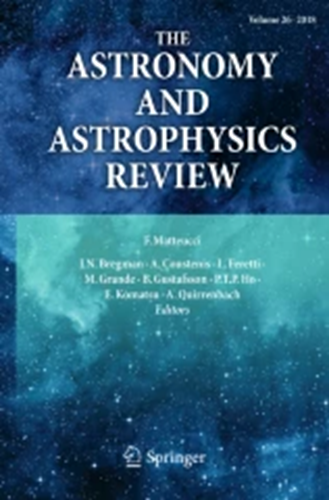Asteroseismology of evolved stars with EGGMiMoSA. I. Theoretical mixed-mode patterns from the subgiant to the RGB phase
IF 26.5
1区 物理与天体物理
Q1 ASTRONOMY & ASTROPHYSICS
引用次数: 2
Abstract
This study is the first of a series of papers that provide a technique to analyse the mixed-modes frequency spectra and characterise the structure of stars on the subgiant and red-giant branches. We define seismic indicators, relevant of the stellar structure and study their evolution on a grid of models. The proposed method, EGGMiMoSA, relies on the asymptotic description of mixed modes, defines initial guesses for the parameters, and uses a Levenberg-Marquardt technique to adjust the mixed-modes pattern efficiently. We follow the evolution of the mixed-modes parameters along a grid of models from the subgiant phase to the RGB bump and extend past works. We show the impact of the mass and composition on their evolution. The evolution of the period spacing $\Delta\pi_1$, pressure offset $\epsilon_p$, gravity offset $\epsilon_g$, and coupling factor $q$ as a function of $\Delta\nu$ is little affected by the chemical composition and it follows two different regimes depending on the evolutionary stage. On the subgiant branch, the models display a moderate core-envelope density contrast. The evolution of $\Delta \pi_1$, $\epsilon_p$, $\epsilon_g$, and $q$ thus significantly changes with the mass. Also, we demonstrate that, at fixed Z/X and with proper measurements of $\Delta\pi_1$ and $\Delta\nu$, we may unambiguously constrain the mass, radius and age of a subgiant star. Conversely, on the red-giant branch, the core-envelope density contrast becomes very large. Consequently, the evolution of $\epsilon_p$, $\epsilon_g$ and $q$ as a function of $\Delta\nu$ becomes independent of the mass. This is also true for $\Delta \pi_1$ in stars with masses $\lesssim 1.8M_\odot$ because of core electron degeneracy. This degeneracy is lifted for higher masses, again allowing for a precise measurement of the age. Overall, our computations qualitatively agree with past observed and theoretical studies.演化恒星的星震学与EGGMiMoSA。1 .从亚巨星到RGB阶段的理论混合模式
这项研究是一系列论文中的第一篇,这些论文提供了一种分析混合模式频谱和表征亚巨星和红巨星分支上恒星结构的技术。我们定义了与恒星结构相关的地震指标,并在模型网格上研究了它们的演变。该方法基于混合模态的渐近描述,定义参数的初始猜测值,并利用Levenberg-Marquardt技术对混合模态进行有效调整。我们沿着模型网格跟踪混合模式参数从亚巨相到RGB凸起的演变,并扩展了过去的工作。我们展示了质量和成分对它们演化的影响。周期间隔的演变 $\Delta\pi_1$、压力偏移 $\epsilon_p$、重力偏移 $\epsilon_g$、耦合系数 $q$ 作为的函数 $\Delta\nu$ 几乎不受化学成分的影响,它遵循两种不同的制度,取决于进化阶段。在亚巨支上,模型显示出中等的核-包层密度对比。的演变 $\Delta \pi_1$, $\epsilon_p$, $\epsilon_g$,和 $q$ 因此随着质量的变化而显著变化。此外,我们证明,在固定的Z/X和适当的测量 $\Delta\pi_1$ 和 $\Delta\nu$,我们可以明确地确定一颗亚巨星的质量、半径和年龄。相反,在红巨星树枝上,核心-包层密度对比变得非常大。因此,进化 $\epsilon_p$, $\epsilon_g$ 和 $q$ 作为的函数 $\Delta\nu$ 变得与质量无关。这也适用于 $\Delta \pi_1$ 在有质量的恒星中 $\lesssim 1.8M_\odot$ 因为核心电子简并。对于更高的质量,这种简并被解除,再次允许对年龄的精确测量。总的来说,我们的计算在质量上与过去的观测和理论研究一致。
本文章由计算机程序翻译,如有差异,请以英文原文为准。
求助全文
约1分钟内获得全文
求助全文
来源期刊

The Astronomy and Astrophysics Review
地学天文-天文与天体物理
CiteScore
45.00
自引率
0.80%
发文量
7
期刊介绍:
The Astronomy and Astrophysics Review is a journal that covers all areas of astronomy and astrophysics. It includes subjects related to other fields such as laboratory or particle physics, cosmic ray physics, studies in the solar system, astrobiology, instrumentation, and computational and statistical methods with specific astronomical applications. The frequency of review articles depends on the level of activity in different areas. The journal focuses on publishing review articles that are scientifically rigorous and easily comprehensible. These articles serve as a valuable resource for scientists, students, researchers, and lecturers who want to explore new or unfamiliar fields. The journal is abstracted and indexed in various databases including the Astrophysics Data System (ADS), BFI List, CNKI, CNPIEC, Current Contents/Physical, Chemical and Earth Sciences, Dimensions, EBSCO Academic Search, EI Compendex, Japanese Science and Technology, and more.
 求助内容:
求助内容: 应助结果提醒方式:
应助结果提醒方式:


